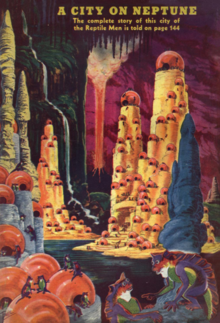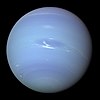Neptune in fiction

Neptune was discovered in 1846 and has only made occasional appearances in fiction since then.[1] The first time it was mentioned, then called "Leverrier's planet", was in the 1848 novel by Charles Rowcroft where an inhabitant of the planet visits Earth.[2] The earliest stories where Neptune itself directly appears as a setting, such as the 1930s works "" by and Last and First Men by Olaf Stapledon, portray it as a rocky planet rather than as having its actual gaseous composition;[3] in the latter, it becomes humanity's refuge in the far future when the Sun expands.[1][3][4] Later works rectified this error, with Alexei Panshin's 1969 short story "" depicting a voyage into Neptune's atmosphere[3] and Alex Irvine's 2003 story "" featuring resource extraction in the atmosphere.[2] In the 1969 novel Macroscope by Piers Anthony, Neptune is converted to a world ship.[1]
Neptune's largest moon Triton was discovered less than a month after the planet.[2] A few works in the 1930s depicted humans going to Triton, looking for minerals in Roman Frederick Starzl's "" and a permanent home in John R. Pierce's "".[3] In the late 20th century it started receiving more attention from science fiction writers than Neptune itself.[2] The main such work is Samuel R. Delany's 1976 novel Triton (also known as Trouble on Triton: An Ambiguous Heterotopia) which depicts future societies living there.[3][5] In the 1994 novel by Jeffrey Carver, an alien on Triton helps humanity avert an impact event.[4]
See also[]
References[]
- ^ a b c Clute, John; Langford, David; Sleight, Graham (eds.). "Outer Planets". The Encyclopedia of Science Fiction. Retrieved 2021-11-04.
{{cite web}}: CS1 maint: url-status (link) - ^ a b c d Stableford, Brian M. (2006). "Neptune". Science Fact and Science Fiction: An Encyclopedia. Taylor & Francis. p. 328. ISBN 978-0-415-97460-8.
- ^ a b c d e Westfahl, Gary (2021-07-19). "Outer Planets". Science Fiction Literature through History: An Encyclopedia [2 volumes]. ABC-CLIO. pp. 485–487. ISBN 978-1-4408-6617-3.
- ^ a b McKinney, Richard L. (2005). "Jupiter and the Outer Planets". In Westfahl, Gary (ed.). The Greenwood Encyclopedia of Science Fiction and Fantasy: Themes, Works, and Wonders. Greenwood Publishing Group. p. 449. ISBN 978-0-313-32951-7.
- ^ Clute, John; Langford, David; Sleight, Graham (eds.). "Delany, Samuel R". The Encyclopedia of Science Fiction. Retrieved 2021-11-04.
{{cite web}}: CS1 maint: url-status (link)
- Fiction set on Neptune
- Fiction set on Neptune's moons
- Fiction about ice giants
